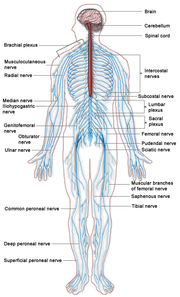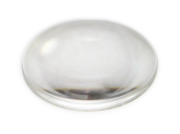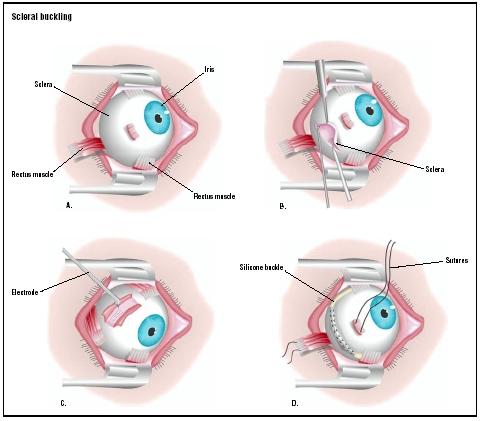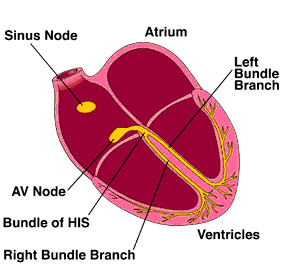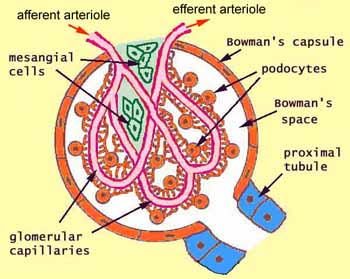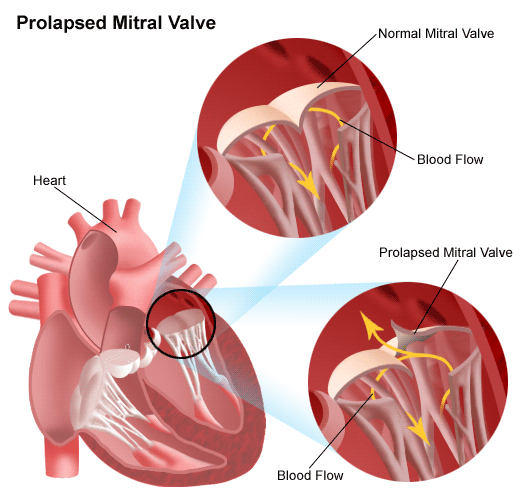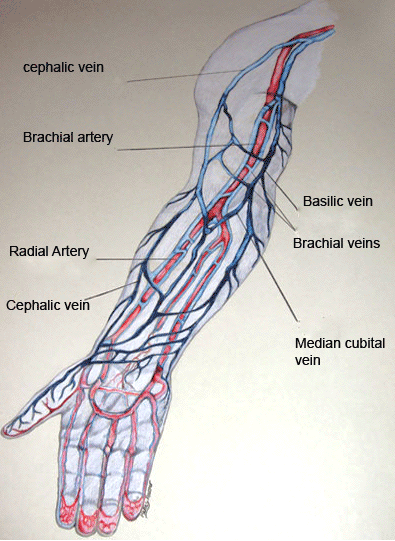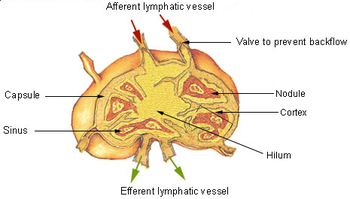|
Brain |
|
Brain is a mass of nerve tissue well protected by membranes in teh cranium, or skull.
|
| Central nervous system |
| The central nervous system (CNS) is the part of the nervous system that functions to coordinate the activity of all parts of the bodies of multicellular organisms. In vertebrates, the central nervous system is enclosed in the meninges. It contains the majority of the nervous system and consists of the brain (in vertebrates which have them), and the spinal cord. Together with the peripheral nervous system it has a fundamental role in the control of behavior. The CNS is contained within the dorsal cavity, with the brain in the cranial cavity and the spinal cord in the spinal cavity. The brain is protected by the skull, while the spinal cord is protected by the vertebrae. |
| cerebellum |
| The cerebellum (Latin for little brain) is a region of the brain that plays an important role in the integration of sensory perception, coordination and motor control. In order to coordinate motor control, there are many neural pathways linking the cerebellum with the cerebral motor cortex (which sends information to the muscles causing them to move) and the spinocerebellar tract (which provides proprioceptive feedback on the position of the body in space). The cerebellum integrates these pathways, like a train conductor, using the constant feedback on body position to fine-tune motor movements |
|
cerebrospinal fluid |
|
Cerebrospinal fluid (CSF), Liquor cerebrospinalis, is a clear bodily fluid that occupies the subarachnoid space and the ventricular system around and inside the brain. Essentially, the brain "floats" in it. More specifically the CSF occupies the space between the arachnoid mater (the middle layer of the brain cover, meninges) and the pia mater (the layer of the meninges closest to the brain). It constitutes the content of all intra-cerebral (inside the brain, cerebrum) ventricles, cisterns and sulci (singular sulcus), as well as the central canal of the spinal cord. |
| cerebrum |
|
The cerebrum or telencephalon, together with the diencephalon, constitute the forebrain. It is the most anterior or, especially in humans, most superior region of the vertebrate central nervous system. "Telencephalon" refers to the embryonic structure, from which the mature "cerebrum" develops. The dorsal telencephalon, or pallium, develops into the cerebral cortex, and the ventral telencephalon, or subpallium, becomes the basal ganglia. The cerebrum is also divided into symmetric left and right cerebral hemispheres. |
| diencephalon |
|
The diencephalon (or interbrain) is the region of the brain that includes the thalamus, hypothalamus, epithalamus, prethalamus or subthalamus and pretectum. The diencephalon is located at the midline of the brain, above the mesencephalon of the brain stem. The diencephalon contains the zona limitans intrathalamica as morphological boundary and signalling center between the prethalamus and the thalamus. |
|
hypothalamus  |
|
The hypothalamus is a portion of the brain that contains a number of small nuclei with a variety of functions. One of the most important functions of the hypothalamus is to link the nervous system to the endocrine system via the pituitary gland (hypophysis). The hypothalamus, (from Greek ὑποθαλαμος = under the thalamus) is located below the thalamus, just above the brain stem. In the terminology of neuroanatomy, it forms the ventral part of the diencephalon. All vertebrate brains contain a hypothalamus. In humans, it is roughly the size of an almond. The hypothalamus is responsible for certain metabolic processes and other activities of the Autonomic Nervous System. It synthesizes and secretes neurohormones, often called hypothalamic-releasing hormones, and these in turn stimulate or inhibit the secretion of pituitary hormones. The hypothalamus controls body temperature, hunger, thirst, [1] fatigue, anger, and circadian cycles.
|
|
medulla oblongata 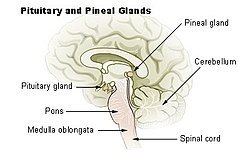 |
|
The medulla oblongata is the lower portion of the brainstem. It deals with autonomic functions, such as breathing and blood pressure. The cardiac center is the part of the medulla oblongata responsible for controlling the heart rate. |
|
Meninges 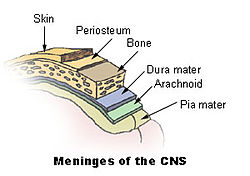 |
| The meninges (singular meninx) is the system of membranes which envelops the central nervous system. The meninges consist of three layers: the dura mater, the arachnoid mater, and the pia mater. The primary function of the meninges and of the cerebrospinal fluid is to protect the central nervous system. |
|
midbrain
|
|
The midbrain is the smallest region of the brain that acts as a sort of relay station for auditory and visual information. The midbrain controls many important functions such as the visual and auditory systems as well as eye movement. Portions of the midbrain called the red nucleus and the substantia nigra are involved in the control of body movement. The darkly pigmented substantia nigra contains a large number of dopamine-producing neurons are located. The degeneration of neurons in the substantia nigra is associated with Parkinson’s disease. |
|
nerves
|
|
A nerve is an enclosed, cable-like bundle of peripheral axons (the long, slender projections of neurons). A nerve provides a common pathway for the electrochemical nerve impulses that are transmitted along each of the axons. Nerves are found only in the peripheral nervous system. In the central nervous system, the analogous structures are known as tracts. Neurons are sometimes called nerve cells, though this term is technically inaccurate since many neurons do not form nerves, and nerves also include non-neuronal Schwann cells that coat the axons in myelin. |
|
nervous system
|
| The nervous system is a network of specialized cell that communicate information about an animal's surroundings and itself. It processes this information and causes reactions in other parts of the body. It is composed of neurons and other specialized cells called glia, that aid in the function of the neurons. The nervous system is divided broadly into two categories: the peripheral nervous system and the central nervous system. Neurons generate and conduct impulses between and within the two systems. The peripheral nervous system is composed of sensory neurons and the neurons that connect them to the nerve cord, spinal cord and brain, which make up the central nervous system. In response to stimuli, sensory neurons generate and propagate signals to the central nervous system which then processes and conducts signals back to the muscles and glands. The neurons of the nervous systems of animals are interconnected in complex arrangements and use electrochemical signals and neurotransmitters to transmit impulses from one neuron to the next. The interaction of the different neurons form neural circuits that regulate an organism's perception of the world and what is going on with its body, thus regulating its behavior. Nervous systems are found in many multicellular animals but differ greatly in complexity between species |
|
neuron
|
| Neurons , also known as neurones and nervous cells) are responsive cells in the nervous system that process and transmit information by electrochemical signaling. They are the core components of the brain, the vertebrate spinal cord, the invertebrate ventral nerve cord, and the peripheral nerves. A number of different types of neurons exist: sensory neurons respond to touch, sound, light and numerous other stimuli affecting cells of the sensory organs that then send signals to the spinal cord and brain. Motor neurons receive signals from the brain and spinal cord and cause muscle contractions and affect glands. Inter-neurons connect neurons to other neurons within the brain and spinal cord. Neurons respond to stimuli, and communicate the presence of stimuli to the central nervous system, which processes that information and sends responses to other parts of the body for action. |
|
parasympathetic
|
|
The parasympathetic nervous system (PSNS) is a division of the autonomic nervous system (ANS), along with the sympathetic nervous system (SNS) and enteric nervous system (ENS or "bowels NS"). The ANS is a subdivision of the peripheral nervous system (PNS). ANS sends fibers to three tissues: cardiac muscle, smooth muscle, or glandular tissue. This stimulation, sympathetic or parasympathetic, is to control smooth muscle contraction, regulate cardiac muscle, or stimulate or inhibit glandular secretion. The actions of the parasympathetic nervous system can be summarized as "rest and digest" (as opposed to the "fight-or-flight" effects of the sympathetic nervous system). |
| The peripheral nervous system (PNS) resides or extends outside the central nervous system (CNS), which consists of the brain and spinal cord. The main function of the PNS is to connect the CNS to the limbs and organs. Unlike the central nervous system, the PNS is not protected by bone or by the blood-brain barrier, leaving it exposed to toxins and mechanical injuries. The peripheral nervous system is divided into the somatic nervous system and the autonomic nervous system. |
|
pons  |
|
The pons (sometimes pons Varolii after Costanzo Varolio) is a structure located on the brain stem. It is cranial to the medulla oblongata, caudal to the midbrain, and ventral to the cerebellum. In humans and other bipeds this means it is above the medulla, below the midbrain, and anterior to the cerebellum. |
| somatic nervous system |
|
The Somatic Nervous System (SNS) includes all nerves controlling the muscular system and external sensory receptors. External sense organs (including skin) are receptors. Muscle fibers and gland cells are effectors. The reflex arc is an automatic, involuntary reaction to a stimulus. When the doctor taps your knee with the rubber hammer, she/he is testing your reflex (or knee-jerk). The reaction to the stimulus is involuntary, with the CNS being informed but not consciously controlling the response. Examples of reflex arcs include balance, the blinking reflex, and the stretch reflex. Sensory input from the PNS is processed by the CNS and responses are sent by the PNS from the CNS to the organs of the body. Motor neurons of the somatic system are distinct from those of the autonomic system. Inhibitory signals, cannot be sent through the motor neurons of the somatic system. |
|
spinal cord
|
| The spinal cord is a long, thin, tubular bundle of nervous tissue and support cells that extends from the brain. The brain and spinal cord together make up the central nervous system. Enclosed within, and protected by, the bony vertebral column, the spinal cord functions primarily in the transmission of neural signals between the brain and the rest of the body, but also contains neural circuits that can independently control numerous reflexes and central pattern generators. |
|
sympathetic  |
| The Sympathetic Nervous System (SNS) is a branch of the autonomic nervous system along with the enteric nervous system and parasympathetic nervous system. It is always active at a basal level (called sympathetic tone) and becomes more active during times of stress. Its actions during the stress response comprise the fight-or-flight response. |
|
thalamus
|
|
The thalamus is a pair and symmetric part of the brain. It constitutes the main part of the diencephalon. Function:
Location:
|
|
ventricles
|
|
Brain ventricle: One of a system of four communicating cavities within the brain that are continuous with the central canal of the spinal cord. The four ventricles consist of the two lateral ventricles, the third ventricle and the fourth ventricle:
The ventricles are filled with cerebrospinal fluid, which is formed by structures called choroid plexuses located in the walls and roofs of the ventricles. |
|
aqueous humor
|
| The aqueous humor is a thick watery substance that is between the lens and the cornea. |
|
auditory canal  |
|
Definition noun The ear canal, running from the auricle to the tympanic membrane.
The human ear canal extends from the pinna to the eardrum and is about 26 mm in length and 7 mm in diameter. It consists of the cartilaginous and the bony parts. |
|
auricle
|
|
Auricle has the following meanings:
|
|
choroid coat
|
| choroid coat - a highly vascular membrane in the eye between the retina and the sclera; a dark pigmentation minimizes the scattering of light inside the eye |
|
cochlea
|
|
The cochlea is the auditory portion of the inner ear. Its core component is the Organ of Corti, the sensory organ of hearing, which is distributed along the partition separating fluid chambers in the coiled tapered tube of the cochlea. The name is from the Latin for snail, which is from the Greek kokhlias "snail, screw," from kokhlos "spiral shell,"(etymology) in reference to its coiled shape; the cochlea is coiled in most mammals, monotremes being the exceptions. |
|
Conjunctiva
|
| The conjunctiva is a clear mucous membrane consisting of cells and underlying basement membrane that covers the sclera (white part of the eye) and lines the inside of the eyelids. It is made of epithelial tissue. |
|
cornea 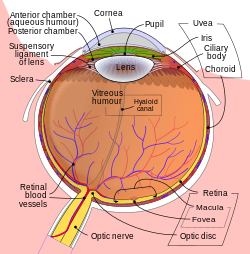 |
| The cornea is the transparent front part of the eye that covers the iris, pupil, and anterior chamber. Together with the lens, the cornea refracts light, and as a result helps the eye to focus, accounting for approximately two-thirds of the eye's total optical power. In humans, the refractive power of the cornea is approximately 43 dioptres. While the cornea contributes most of the eye's focusing power, its focus is fixed. The curvature of the lens, on the other hand, can be adjusted to "tune" the focus depending upon the object's distance. |
|
eustachian tube
|
| The Eustachian tube (or auditory tube) is a tube that links the pharynx to the middle ear. In adults the Eustachian tube is approximately 35 mm long. It is named after the sixteenth century anatomist Eustachius. Some modern medical books call this the pharyngotympanic tube |
|
iris  |
| The iris is a membrane in the eye, responsible for controlling the amount of light reaching the retina. The iris consists of pigmented fibrovascular tissue known as a stroma. It is the most forward portion of the eye and the only one seen on superficial inspection. The stroma connects a sphincter muscle (sphincter pupillae), which contracts the pupil, and a set of dilator muscles (dilator pupillae) which open it. The back surface is covered by a heavily pigmented epithelial layer two cells thick (the iris pigment epithelium), but the front surface has no epithelium. The high pigment content blocks light from passing through the iris and restricts it to the pupil. The outer edge of the iris, known as the root, is attached to the sclera and the anterior ciliary body. The iris and ciliary body together are known as the anterior uvea. Just in front of the root of the iris is the region through which the aqueous humour constantly drains out of the eye, with the result that diseases of the iris often have important effects on intraocular pressure, and indirectly on vision. Depending on the amount of light, the iris makes the pupil larger or smaller. |
|
lacrimal glands 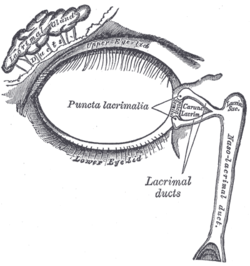 |
|
The lacrimal glands are paired almond-shaped glands, one for each eye, that secrete the aqueous layer of the tear film. They are situated in the upper, outer portion of each orbit. Inflamation of the lacrimal glands is called lacrimitis. |
|
lens
|
|
lens is an optical device with perfect or approximate axial symmetry which transmits and refracts light, converging or diverging the beam. A simple lens is a lens consisting of a single optical element. A compound lens is an array of simple lenses (elements) with a common axis; the use of multiple elements allows more optical aberrations to be corrected than is possible with a single element. Manufactured lenses are typically made of glass or transparent plastic. Elements which refract electromagnetic radiation outside the visual spectrum are also called lenses: for instance, a microwave lens can be made from paraffin wax. The obsolescent spelling lense is sometimes seen, but Merriam-Webster's medical dictionary is the only major dictionary that considers this to be correct |
|
organ of Corti |
| The organ of Corti (or spiral organ) is the organ in the inner ear of mammals that contains auditory sensory cells, or "hair cells." |
|
Ossicles
|
|
The ossicles (also called auditory ossicles) are the three smallest bones in the human body. They are contained within the middle ear space and serve to transmit sounds from the air to the fluid-filled labyrinth (cochlea). The absence of the auditory ossicles would constitute a moderate-to-severe hearing loss. The term "ossicles" literally means "tiny bones" and commonly refers to the auditory ossicles, though the term may refer to any small bone throughout the body. |
|
pinna
|
| Pinna (anatomy), the outer part of the ear - also referred to as the auricle |
|
pupil
|
|
The pupil is the sphere that is located in the center of the iris of the eye and that controls the amount of light that enters the eye. It appears black because most of the light entering the pupil is absorbed by the tissues inside the eye. In optical terms, the anatomical pupil is the eye's aperture and the iris is the aperture stop. The image of the pupil as seen from outside the eye is the entrance pupil, which does not exactly correspond to the location and size of the physical pupil because it is magnified by the cornea. On the inner edge lies a prominent structure, the collarette, marking the junction of the embryonic pupillary membrane covering the embryonic pupil. |
|
refracts
|
| To deflect (light, for example) from a straight path by refraction. |
|
retina
|
| delicate, multilayered, light-sensitive membrane lining the inner eyeball and connected by the optic nerve to the brain |
|
sclera
|
| The tough white fibrous outer envelope of tissue covering all of the eyeball except the cornea. Also called sclerotic, sclerotic coat |
|
semicircular canals
|
|
The semicircular canals are three half-circular, interconnected tubes located inside each ear. The three canals are the horizontal semicircular canal, superior semicircular canal (aka anterior semicircular canal), and the posterior semicircular canal. The canals are aligned approximately orthogonally to one another. The horizontal canal is aligned roughly horizontally in the head. The superior and anterior canals are aligned roughly at a 45 degree angle to a vertical plane drawn from the nose to the back of the skull. [1] Thus, the horizontal canal detects horizontal head movements (such as when doing a pirouette), while the superior and posterior canals detect vertical head movements. Each canal is filled with a fluid called endolymph and contains a motion sensor with little hairs (cilia) whose ends are embedded in a gelatinous structure called the cupula. As the skull twists in any direction, the endolymph is thrown into different sections of the canals. The cilia detect when the endolymph rushes past, and a signal is then sent to the brain. The Semicircular canals are a component of the Labyrinth. |
|
tympanic membrane
|
| Anat the thin membrane separating the external ear from the middle ear; eardrum |
|
vestibule
|
| Anatomy A cavity, chamber, or channel that leads to or is an entrance to another cavity: the vestibule to the ear. |
|
vitreous humor
|
| The clear gelatinous substance that fills the eyeball between the retina and the lens |
|
aortic valve
|
|
A valve located in the aorta that prevents the backflow of blood to the left ventricle. |
|
arrhythmias
|
|
is a term for any of a large and heterogeneous group of conditions in which there is abnormal electrical activity in the heart. The heart beat may be too fast or too slow, and may be regular or irregular. Some arrhythmias are life-threatening medical emergencies that can result in cardiac arrest and sudden death. Others cause aggravating symptoms such as an abnormal awareness of heart beat (palpitations), and may be merely annoying. Others may not be associated with any symptoms at all, but pre-dispose toward potentially life threatening stroke or embolus. Some arrhythmias are very minor and can be regarded as normal variants. In fact, most people will sometimes feel their heart skip a beat, or give an occasional extra strong beat - neither of which is usually a cause for alarm[1]. The term sinus arrhythmia refers to a normal phenomenon of mild acceleration and slowing of the heart rate that occurs with breathing in and out. It is usually quite pronounced in children, and steadily lessens with age. This can also present during meditation breathing exercises that involve deep inhaling and breath holding patterns. |
|
arteries
|
| Anatomy Any of the muscular elastic tubes that form a branching system and that carry blood away from the heart to the cells, tissues, and organs of the body. |
|
blood
|
| The fluid consisting of plasma, blood cells, and platelets that is circulated by the heart through the vertebrate vascular system, carrying oxygen and nutrients to and waste materials away from all body tissues. |
|
capillaries
|
| Anatomy One of the minute blood vessels that connect arterioles and venules. These blood vessels form an intricate network throughout the body for the interchange of various substances, such as oxygen and carbon dioxide, between blood and tissue cells. |
|
circulatory system
|
|
The system that circulates blood through the body, consisting of the heart and blood vessels. In all vertebrates and certain invertebrates, the circulatory system is completely contained within a network of vessels (known as a closed circulatory system). In arthropods and many other invertebrates, a substance analogous to blood (known as hemolymph) is pumped through vessels that open into the intercellular spaces (in what is known as an open circulatory system). In vertebrates, the lymphatic system is also considered part of the circulatory system.
|
|
endocardium
|
| The thin serous membrane, composed of endothelial tissue, that lines the interior of the heart |
|
erythrocytes
|
| a red blood cell that transports oxygen through the body |
|
hemoglobin
|
| An iron-containing protein present in the blood of many animals that, in vertebrates, carries oxygen from the lungs to the tissues of the body and carries carbon dioxide from the tissues to the lungs. Hemoglobin is contained in the red blood cells of vertebrates and gives these cells their characteristic color. Hemoglobin is also found in many invertebrates, where it circulates freely in the blood. It consists of four peptide units, each attached to a nonprotein compound called heme that binds to oxygen. |
|
left atrium
|
| the left upper chamber of the heart that receives blood from the pulmonary veins |
|
left ventricle
|
| the chamber on the left side of the heart that receives arterial blood from the left atrium and pumps it into the aorta |
|
leukocytes
|
| any of the various large white cells in the blood of vertebrates |
|
mitral valve
|
| a valve of the heart, composed of two triangular flaps, that is located between the left atrium and left ventricle and regulates blood flow between these chambers. Also called bicuspid valve, left atrioventricular valve |
|
myocardium
|
| the muscular tissue of the heart |
|
pericardium
|
| The membranous sac filled with serous fluid that encloses the heart and the roots of the aorta and other large blood vessels |
|
plasma
|
|
. The clear, yellowish fluid portion of blood, lymph, or intramuscular fluid in which cells are suspended. It differs from serum in that it contains fibrin and other soluble clotting elements. b. Blood plasma.
|
|
pulmonary valve
|
| pulmonary valve - a semilunar valve between the right ventricle and the pulmonary artery; prevents blood from flowing from the artery back into the heart |
|
right atrium
|
| right atrium - the right upper chamber of the heart that receives blood from the venae cavae and coronary sinus |
|
right ventricle
|
| right ventricle - the chamber on the right side of the heart that receives venous blood from the right atrium and pumps it into the pulmonary trunk |
|
septum
|
| A thin partition or membrane that divides two cavities or soft masses of tissue in an organism: the nasal septum; the atrial septum of the heart |
|
systole
|
|
The rhythmic contraction of the heart, especially of the ventricles, by which blood is driven through the aorta and pulmonary artery after each dilation or diastole.
|
|
thrombocytes
|
| thrombocyte - tiny bits of protoplasm found in vertebrate blood; essential for blood clotting |
|
tricuspid valve
|
|
A valve of the heart, usually having three cusps, that is located between the right atrium and right ventricle. The tricuspid valve prevents the backflow of blood to the right atrium.
|
|
veins
|
|
a. Anatomy Any of the membranous tubes that form a branching system and carry blood to the heart. b. A blood vessel.
|
|
cisterna chyli
|
| Anatomy A fluid-containing sac or cavity in the body of an organism. Also called reservoir |
|
lacteals
|
|
A lacteal is a lymphatic capillary that absorbs dietary fats in the villi of the small intestine. The combination of fat and lymph in the lacteals is milky in appearance and called chyle. Individual lacteals merge to form larger lymphatic vessels that transport the fats to the thoracic duct which empties into the left subclavian vein found under the collar bone. |
|
lymph nodes
|
|
A Lymph node is an organ consisting of many types of cells, and is a part of the lymphatic system. Lymph nodes are found all through the body, and act as filters or traps for foreign particles. They contain white blood cells. Thus they are important in the proper functioning of the immune system. Lymph nodes also have clinical significance. They become inflamed or enlarged in various conditions, which may range from trivial, such as a throat infection, to life-threatening such as cancers. In the latter, the condition of lymph nodes is so significant that it is used for cancer staging, which decides the treatment modalities to be employed, and for determining the prognosis. Lymph nodes can also be diagnosed by biopsy whenever they are inflamed. Certain diseases affect lymph nodes with characteristic consistency and location |



